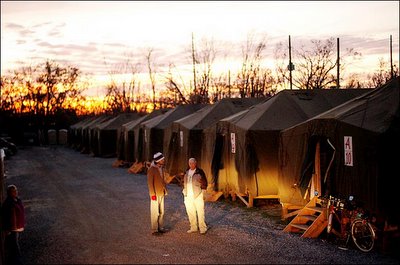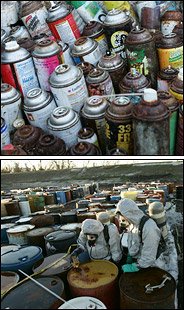
[Image: A “tent city in Pass Christian, Miss.” – Ozier Muhammad/New York Times].
“From a distance, it looks like an Army base camp… But here, a little more than a stone’s throw from the Gulf of Mexico, on a muddy gravel lot that used to be a Little League field, a makeshift village has emerged for some of the many families who, as winter approaches, are still homeless because of Hurricane Katrina.”
As the subtropical ruins of New Orleans continue to mold, buried under mountains of now toxic rubbish (“Contractors have disposed of more than six million pounds of waste… There have been 222,000 refrigerators, washers and dryers gathered, and more than a million containers of hazardous waste have been plucked from land and sea”), the less fortunate members of that obliterated city’s displaced population now live in temporary camps – “canvas cities,” as the New York Times calls them.
Here, the tents “are set up in long, straight rows and distinguished only by alphanumeric addresses painted on their exteriors.” With rough plywood floors, they’re far from luxurious: “The toilets are portable, without running water, and are lined up near a tractor-trailer that serves as a shower house.”
So in a nation faced with rapidly failing civic infrastructure, are these the cities of the future? Instant, poor, and shoddily maintained?
“Boredom is perhaps the biggest problem in the tent cities,” we read. Yet one can clearly add the words: for now.

[Image: “Workers in protective gear inspecting drums for toxic chemicals last week at a reclamation site near Buras, La., near the Mississippi River levee. The detritus included piles of discarded spray cans, top.” Ozier Muhammad/New York Times].
(For more on Katrina, housing, and the architectural response to disaster, see this excellent resource at Archinect).